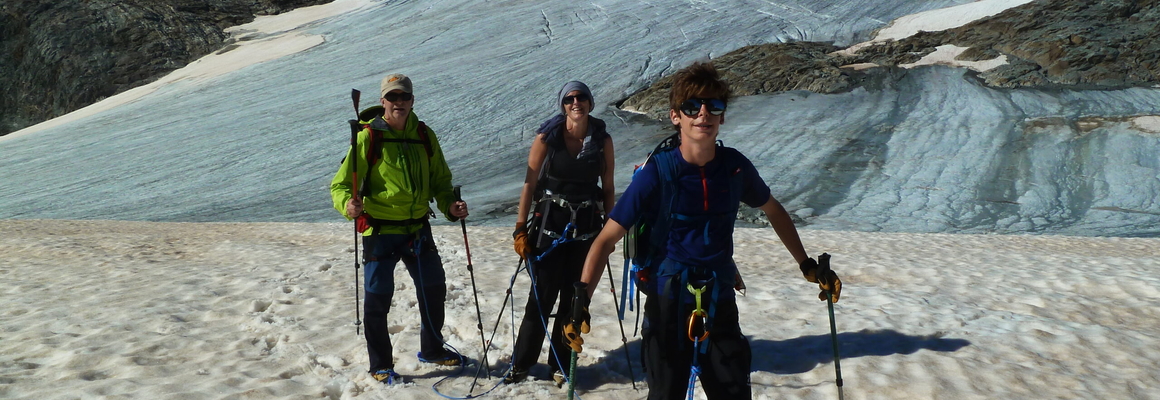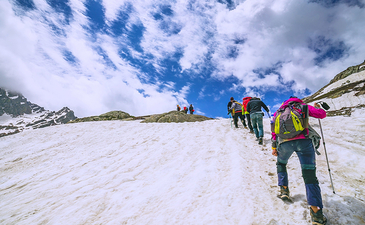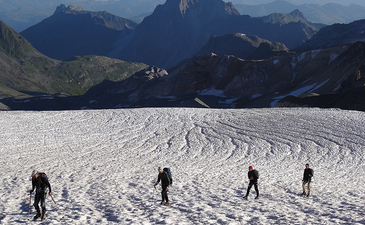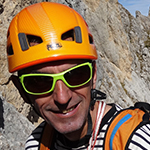
Original downhill sports in Méribel, Savoie
…on your marks... get set... down ! 💨
June 29, 2022

Imaginez quelques instants : après avoir passé la nuit au-dessus de 2 500 m d’altitude, au petit matin, vous partez du refuge à la frontale.


Just imagine: after spending the night above 2,500 m, in the early morning, you leave the refuge by the light of a headlamp. In the darkness, the lights of other mountaineers ascend the glacier. To join them, you put on your crampons and your guide ropes you together. Until now you have always stopped on the hiking trail below. This time it’s different, you go higher, much higher: off the beaten track. Away from the hustle and bustle of the cities, you have a front row seat view of the sunrise over the glacier and chances are that this introduction to the glacier will stay with you forever. You will experience the feeling shared by all climbers: of being so small and at the same time in exactly the right place.
To help you organise your glacier trekking initiation, we interviewed Alain Petex, a guide based in Méribel for over 20 years. From Meribel, you are at the gateway to the Vanoise National Park, known for its many glaciers and peaks over 3,000m high. So if you dream of doing your first 3,000 m, here is how a glacier hike is done with the Méribel Bureau des Guides.

Alain Petex : “I have been a mountain guide in Méribel for at least 20 years. I live in Bride-les-Bains but I am originally from Moûtiers. I arrived in Méribel thanks to Frédéric Saint Guilhem, a former high mountain guide and hotelier in Méribel. At the time, he was looking for a young guide to help him, and that is how I came to work in Méribel.
The Vanoise is a range that I like very much. The landscapes combine the green of the mountain pastures, the blue of the sky and the white of the glaciers which culminate at 3,000 m. This creates a very special atmosphere, one that you don’t find in other mountain ranges.”
Alain Petex: “At the Méribel guide office, there are 5 high mountain guides and 2 mid-mountain walking leaders in the summer. However, in winter, we are about ten guides for ski touring, off-piste skiing or ice climbing.”
Alain Petex: “We offer 2 options.
It is important to know that in summer, a glacier hike must be done very early in the morning. The reason is simple: when it is too hot, the snow melts. You sink into the snow, so it’s harder to walk. It can also be a bit dangerous because on a glacier there are crevasses that can be more or less covered by snow bridges. Early in the morning, when the snow is hard, you can walk on these snow bridges without sinking. To stay safe, you have to be off the glacier by noon or 1pm.”
Alain Petex: “For the first option, which involves going up to a refuge on the first day, you can go to the Col de la Vanoise refuge to do the Pointe de la Réchasse or the Pointe du Dard located on the dome of the Vanoise glaciers. The Col de la Vanoise refuge can be reached in a 3-hour walk from Pralognan via the Lac des Vaches. The approach is already a journey in itself, as the setting is magnificent. This refuge is located at 2,500m and the summits are at 3,200m. From the refuge, you have to walk for 2.5 to 3 hours to reach the summit.
Then there is also the Péclet-Polset refuge, which allows you to climb to the Polset dome at 3,501m. The climb requires 4 hours of walking, but the glacier is much more substantial than the first option. It is a glacier with crevasses and seracs, it is still a glacier walk, but in a different atmosphere from the dome of the Vanoise glaciers.
Finally, there is the option that we propose for the day, leaving from Meribel. We leave early by car to reach a road situated at 2,800m, above Val Thorens. We arrive there at 7 am. We then go up to the Chavière glacier, and from there, several options are possible depending on the level of the participants: climb to 3,200 m or climb to the Gébroulaz mountain at 3,509 m.”
| Alain Petex: “Glacier trekking is the ideal discipline to start mountaineering. There is very little danger, much less than on more vertical mountaineering routes. On these introductory courses, there are no steep slopes on which you could get hurt by slipping. These are glaciers with gentle slopes.
The only danger is crevasses. That’s why we are roped together. If someone falls into a crevasse, he stays on the surface and gets out easily. Personally, I’ve been a guide for 25 years and I’ve never fallen into a crevasse and I’ve never seen a client fall in. The rope in alpine climbing is like the safety belt in a car. You put it on, but that doesn’t mean you’re going to use it. “ |
“Personally, I’ve been a guide for 25 years and I’ve never fallen into a crevasse and I’ve never seen a client fall in.” |
Alain Petex: “For the routes we have just mentioned, you need to be able to climb at least 800 metres without being exhausted. By way of comparison, the hike from the Lac de Tueda to the Refuge du Saut, a classic in the summer in Méribel, requires an increase in altitude of 450 metres. However, for day-long initiations, it is possible to choose an itinerary with only 300m of ascent to reach the glacier. The destination of the day is always chosen by discussion. We ask a number of questions about your experience in the high mountains, your physical level, your potential fear of heights… Using these elements, we then propose options.”
Alain Petex: “No, as the name suggests, it’s only glacier walking. But there are other mountaineering routes in the Vanoise that require a little mountaineering or climbing experience to be done. It’s all about finding the right mountaineering trip for you and your level. ”
Alain Petex: “You have to rent the equipment in the rental shops in Meribel, i.e. crampons, shoes suitable for crampons, a harness, a straight ice axe, a helmet and a pair of walking sticks… and obviously you have to have the necessary equipment for the cold and the sun, which is more intense at 3,000m: category 4 glasses, gloves, a down jacket and a windproof jacket…
Finally, there is the equipment provided by the guide’s office: the rope and the safety equipment on the glacier, such as ice pins. How to use this equipment is obviously explained afterwards by the guide on the day.”
Alain Petex: “Yes, glacier trekking with the family is possible. Children are allowed from the age of 12. If the children are good walkers, you can start a little bit earlier, but in most cases, family glacier trekking is more likely to be done around 12 years old.”
Alain Petex: “The first step is to send an email to the guide’s office before your holiday to get in touch with us. This allows us to choose an itinerary and dates. We do our utmost to offer tailor-made outings to our clients. Then, there are two possibilities: you can either come with a group (maximum 6 people), or join a group if you are alone. The introductory glacier hikes we mentioned earlier are offered all summer long, from June to the end of August. Finally, for an initiation, the price starts from 140 € / person.”
Alain Petex: “I remember once I took a group to Polset Dome. There was an 18 year old boy there. I saw him again 20 years later and he was still very happy about the trip. That day he had discovered something and continued to climb thereafter. Being introduced to mountaineering finally opens up the high mountains: you discover life in a refuge, you walk roped up with the day gradually breaking over the summits and glaciers, you see crevasses… In short, it’s a unique experience that leaves its mark, like the young man who spoke about it with stars in his eyes 20 years later. ”
Alain Petex: “In the summer, the guide’s office also offers via ferrata, canyoning, climbing, mountaineering and themed hikes. We accompany both sporty people who want to discover or progress in a mountain sport, as well as families and less athletic individuals who want to discover nature and the mountains.